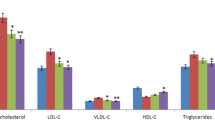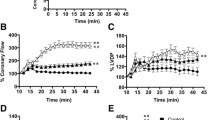Abstract
The present study was designed to elucidate the outcome of subchronic co-administration of black tea and nicotine on cardiovascular performance and whether these substances could modulate the isoproterenol-induced cardiac injury. Animal groups were control, black tea, nicotine and black tea plus nicotine. Test groups received nicotine (2 mg/kg s.c.) and black tea brewed (p.o.) each alone and in combination for 4 weeks. On the 28th day, myocardial damage was induced by isoproterenol (50 mg/kg i.p.), and blood samples were taken. On day 29, after hemodynamic parameters recording, hearts were removed for histopathological evaluation. Tea or nicotine consumption had no significant effects on hemodynamic indices of animals without heart damage. When the cardiac injury was induced, tea consumption maintained the maximum dp/dt, and nicotine significantly decreased the pressure–rate product. Moreover, severity of heart lesions was lower in the presence of nicotine or black tea. Concomitant use of these materials did not show extra effects on mentioned parameters more than the effect of each of them alone. The results suggest that subchronic administration of black tea or nicotine for a period of 4 weeks may have a mild cardioprotective effect, while concomitant use of these materials cannot intensify this beneficial effect.



Similar content being viewed by others
References
Andresen JH, Godang K, Munkeby BH, Stray-Pedersen B, Saugstad OD (2008) Nicotine in a small-to-moderate dose does not cause a significant increase in plasma catecholamine levels in newborn piglets. Neonatology 94:279–283
Andresen JH, Solberg R, Løberg EM, Munkeby BH, Stray-Pedersen B, Saugstad OD (2008) Resuscitation with 21 or 100% oxygen in hypoxic nicotine-pretreated newborn piglets: possible neuroprotective effects of nicotine. Neonatology 93(1):36–44
Apple FS, Smith SW, Pearce LA, Ler R, Murakami MM, Benoit MO, Levy C, Dumas C, Paul JL (2008) Use of the bioMérieux VIDAS troponin I ultra assay for the diagnosis of myocardial infarction and detection of adverse events in patients presenting with symptoms suggestive of acute coronary syndrome. Clin Chim Acta 390:72–75
Bellinger LL, Wellman PJ, Harris RB, Kelso EW, Kramer PR (2010) The effects of chronic nicotine on meal patterns, food intake, metabolism and body weight of male rats. Pharmacol Biochem Behav 95(1):92–99
Benowitz N (1998) Nicotine safety and toxicity. Oxford University Press, New York
Dandekar MP, Nakhate KT, Kokare DM, Subhedar NK (2010) Effect of nicotine on feeding and body weight in rats: involvement of cocaine- and amphetamine-regulated transcript peptide. Behav Brain Res [Epub ahead of print]
Duffy SJ, Keaney JFJR, Holbrook M, Gokce N, Swerdloff PL, Frei B, Vita JA (2001) Short- and long-term black tea consumption reverses endothelial dysfunction in patients with coronary artery disease. Circulation 104:151–156
Geleijnse J, Launer L, van der Kuip D, Hofman A, Witteman J (2002) Inverse association of tea and flavonoid intakes with incident myocardial infarction: the Rotterdam Study. Am J Clin Nutr 75:880–886
Gobel FL, Norstrom LA, Nelson RR, Jorgensen CR, Wang Y (1978) The rate–pressure product as an index of myocardial oxygen consumption during exercise in patients with angina pectoris. Circulation 57:549–556
Goldinc JF, Harpur T, Brent-Smith H (1983) Personality, drinking and drug-taking correlates of cigarette smoking. Pers individ diffr 1(6):703–706
Haass M, Kübler W (1997) Nicotine and sympathetic neurotransmission. Cardiovasc Drugs Ther 10(6):657–665
Hamdaoui M, He'dhili A, Doghri T, Tritar B (1997) Effect of tea decoction given to rats ad libitum for a relatively long time on body weight gains and iron, copper, zinc, magnesium concentrations in blood, liver, duodenum and spleen. Ann Nutr Metab 41:196–202
Hendricks R, Pool EJ (2010) The in vitro effects of rooibos and black tea on immune pathways. J Immunoassay Immunochem 31(2):169–180
Khokhar S, Magnusdottir SG (2002) Total phenol, catechins, and caffeine contents of teas commonly consumed in the United Kingdom. J Agric Food Chem 50:565–570
Krishnan R, Maru G (2006) Isolation and analyses of polymeric polyphenol fractions from black tea. Food Chem 94:331–340
Kubík A, Zatloukal P, Tomásek L, Pauk N, Havel L, Dolezal J, Plesko I (2007) Interactions between smoking and other exposures associated with lung cancer risk in women: diet and physical activity. Neoplasma 54(1):83–88
Li Z, Barrios V, Buchholz JN, Glenn TC, Duckles SP (1994) Chronic nicotine administration does not affect peripheral vascular reactivity in the rat. J Pharmacol Exp Ther 271:1135–1142
Lorenz M, Urban J, Engelhardt U, Baumann G, Stangl K, Stangl V (2009) Green and black tea are equally potent stimuli of NO production and vasodilation: new insights into tea ingredients involved. Basic Res Cardiol 104:100–110
Luo HL, Zang WJ, Lu J, Yu XJ, Lin YX, Cao YX (2006) The protective effect of captopril on nicotine-induced endothelial dysfunction in rat. Basic Clin Pharmacol Toxicol 99(3):237–245
Mayhan WG, Sharpe GM (1999) Chronic exposure to nicotine alters endothelium-dependent arteriolar dilatation: effect of superoxide dismutase. J Appl Physiol 86:1126–1134
Moore D, Aveyard P, Connock M, Wang D, Fry-Smith A, Barton P (2009) Effectiveness and safety of nicotine replacement therapy assisted reduction to stop smoking: systematic review and meta-analysis. BMJ 338:b1024
Princen HM, van Duyvenvoorde W, Buytenhek R, Blonk C, Tijburg LB, Langius JA, Meinders AE, Pijl H (1998) No effect of consumption of green and black tea on plasma lipid and antioxidant levels and on LDL oxidation in smokers. Arterioscler Thromb Vasc Biol 18:833–841
Rebello SA, Chen CH, Naidoo N, Xu W, Lee J, Chia KS, Tai ES, Dam RMv (2011) Coffee and tea consumption in relation to inflammation and basal glucose metabolism in a multi-ethnic Asian population: a cross-sectional study. Nutr J 10:61
Rona G, Chappel CI, Balazs T, Gaudry R (1959) An infarct-like myocardial lesion and other toxic manifestations produced by isoproterenol in the rat. AMA Arch Pathol 67:443–455
Rosa AO, Egea J, Gandía L, López MG, García AG (2006) Neuroprotection by nicotine in hippocampal slices subjected to oxygen-glucose deprivation: involvement of the alpha7 nAChR subtype. J Mol Neurosci 30(1–2):61–62
Ruixing Y, Qi B, Tangwei L, Jiaquan L (2007) Effects of nicotine on angiogenesis and restenosis in a rabbit model. Cardiology 107:122–131
Tanwar V, Sachdeva J, Kishore K, Mittal R, Chandra Nag T, Ray R, Kumari S, Singh Arya D (2010) Dose-dependent actions of curcumin in experimentally induced myocardial necrosis: a biochemical, histopathological, and electron microscopic evidence. Cell Biochem Funct 28:74–82
Thomas CB (1973) The relationship of smoking and habits of nervous tension. In: Dunn W (ed) Smoking behavior: motives and incentives. V. H. Winston & Sons, Washington
Uchiyama S, Taniguchi Y, Saka A, Yoshida A, Yajima H (2010) Prevention of diet-induced obesity by dietary black tea polyphenols extract in vitro and in vivo. Nutrition [in press]
Vlachopoulos C, Panagiotakos D, Ioakeimidis N, Dima I, Stefanadis C (2005) Chronic coffee consumption has a detrimental effect on aortic stiffness and wave reflections. Am J Clin Nutr 81:1307–1312
De Vos S, De Schrijver R (2003) Lipid metabolism, intestinal fermentation and mineral absorption in rats consuming black tea. Nutr Res 23:527–537
Wang L, Yan H, Li JG, Chen JL, Song XM, Yan QT, Shi Y (2010) Protective effects of nicotine on inflammatory cytokines in myocardial ischemia/reperfusion injury in rats. Zhongguo Wei Zhong Bing Ji Jiu Yi Xue 22(10):624–627
Wang R, Wang Z (2000) Three different vasoactive responses of rat tail artery to nicotine. Can J Physiol Pharmacol 78:20–28
Wexler BC (1978) Myocardial infarction in young vs old male rats: pathophysiologic changes. Am Heart J 96:70–80
Widlansky ME, Duffy SJ, Hamburg NM, Gokce N, Warden BA, Wiseman S, Keaney JF Jr, Frei B, Vita JA (2005) Effects of black tea consumption on plasma catechins and markers of oxidative stress and inflammation in patients with coronary artery disease. Free Radic Biol Med 38(4):499–506
Winniford MD (1990) Smoking and cardiovascular function. J Hypertens 9:S17–S23
Woodward M, Tunstall-Pedoe H (1999) Coffee and tea consumption in the Scottish Heart Health Study follow up: conflicting relations with coronary risk factors, coronary disease, and all cause mortality. J Epidemiol Community Health 53:481–487
WORLD HEALTH STATISTICS (2010) available via DIALOG. http://www.who.int/whosis/whostat/EN_WHS10_Full.pdf. Accessed 15 Jan 2011
Yashima M, Ohara T, Cao JM, Kim YH, Fishbein MC, Mandel WJ, Chen PS, Karagueuzian HS (2000) Nicotine increases ventricular vulnerability to fibrillation in hearts with healed myocardial infarction. Am J Physiol Heart Circ Physiol 278:H2124–H2133
York M, Scudamore C, Brady S, Chen C, Wilson S, Curtis M, Evans G, Griffiths W, Whayman M, Williams T, Turton J (2007) Characterization of troponin responses in isoproterenol-induced cardiac injury in the Hanover Wistar rat. Toxicol Pathol 35:606–617
Zwar N, Bell J, Peters M, Christiel MD, Mendelsohn C (2006) Nicotine and nicotine replacement therapy—the facts, Pharmacist
Acknowledgments
The authors are grateful to the Neuroscience Research Center, Kerman University of Medical Sciences, for the financial support of this work.
Conflict of interest
The authors declare that there are no conflicts of interest.
Author information
Authors and Affiliations
Corresponding author
Rights and permissions
About this article
Cite this article
Joukar, S., Bashiri, H., Dabiri, S. et al. Cardiovascular effects of black tea and nicotine alone or in combination against experimental induced heart injury. J Physiol Biochem 68, 271–279 (2012). https://doi.org/10.1007/s13105-011-0141-z
Received:
Accepted:
Published:
Issue Date:
DOI: https://doi.org/10.1007/s13105-011-0141-z




